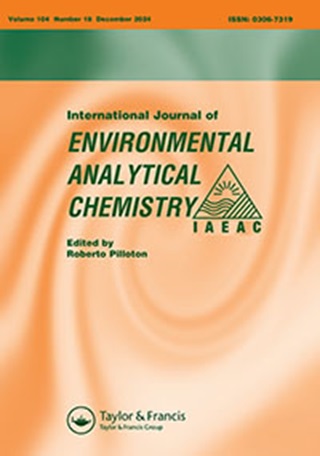Adsorption isotherm and kinetic analysis of molecularly imprinted polymer with two functional monomers for quantification of atrazine
IF 2.5
4区 化学
Q3 CHEMISTRY, ANALYTICAL
International Journal of Environmental Analytical Chemistry
Pub Date : 2023-11-07
DOI:10.1080/03067319.2023.2277888
引用次数: 0
Abstract
ABSTRACTThe extensive use of atrazine as a pesticide in agricultural practices poses a significant risk to the environment and human health. Atrazine, when applied to plants, has the potential to migrate through the soil and contaminate groundwater sources. Consequently, there is an urgent need to explore alternative methods for detecting atrazine. This study aimed to investigate the quantification of atrazine using molecularly imprinted polymer (MIP) and to assess the adsorption performance and kinetics of the MIPs using various isotherm and kinetic adsorption models. MIP was synthesised with two distinct functional monomers: methacrylic acid (MAA) and acrylamide (AA). Computational analysis was employed to estimate the binding affinity of these monomers towards atrazine. Subsequently, results from adsorption capacity study indicated a higher binding affinity for MAA compared to AA with values of 0.92 mg/g and 0.48 mg/g, respectively. These findings aligned with the simulated data from the docking analysis. Moreover, the adsorption mechanism of atrazine towards MIP-MAA and MIP-AA was best represented by Jovanovic model, followed by the Langmuir, Freundlich and Linear models. While for kinetics analysis, the Elovich model was chosen as the best fit. In conclusion, the selection of the functional monomer is of utmost importance in designing MIPs as it facilitates specific interactions with analyte molecules and enhances the performance of the MIPs.KEYWORDS: Molecularly imprinted polymeratrazineadsorption isothermfunctional monomerbinding affinity Disclosure statementNo potential conflict of interest was reported by the author(s).Additional informationFundingThis research was supported by IIUM Research Initiative Grant Scheme (Flagship) 2019 [IRF19-006-0006] from the Ministry of Higher Education, Malaysia.两功能单体分子印迹聚合物对阿特拉津的吸附等温线及动力学分析
摘要阿特拉津作为农药在农业生产中的广泛使用对环境和人类健康造成了重大威胁。阿特拉津在施用于植物时,有可能通过土壤迁移并污染地下水。因此,迫切需要探索检测阿特拉津的替代方法。本研究旨在研究分子印迹聚合物(MIP)对阿特拉津的定量,并利用各种等温和动力学吸附模型评估MIP的吸附性能和动力学。MIP由两种功能单体甲基丙烯酸(MAA)和丙烯酰胺(AA)合成。计算分析了这些单体对阿特拉津的结合亲和力。随后的吸附容量研究结果表明,与AA相比,MAA的结合亲和力更高,分别为0.92 mg/g和0.48 mg/g。这些发现与对接分析的模拟数据一致。Jovanovic模型最能表征阿特拉津对MIP-MAA和MIP-AA的吸附机理,其次是Langmuir模型、Freundlich模型和Linear模型。对于动力学分析,选择Elovich模型作为最佳拟合模型。综上所述,功能单体的选择对于设计MIPs至关重要,因为它促进了与分析物分子的特定相互作用,并提高了MIPs的性能。关键词:分子印迹聚合阿特拉津吸附等温线功能单体结合亲和力披露声明作者未报告潜在利益冲突。本研究由马来西亚高等教育部IIUM研究计划资助计划(旗舰)2019 [IRF19-006-0006]支持。
本文章由计算机程序翻译,如有差异,请以英文原文为准。
求助全文
约1分钟内获得全文
求助全文
来源期刊
CiteScore
5.90
自引率
7.70%
发文量
373
审稿时长
4.4 months
期刊介绍:
International Journal of Environmental Analytical Chemistry comprises original research on all aspects of analytical work related to environmental problems. This includes analysis of organic, inorganic and radioactive pollutants in air, water, sediments and biota; and determination of harmful substances, including analytical methods for the investigation of chemical or metabolic breakdown patterns in the environment and in biological samples.
The journal also covers the development of new analytical methods or improvement of existing ones useful for the control and investigation of pollutants or trace amounts of naturally occurring active chemicals in all environmental compartments. Development, modification and automation of instruments and techniques with potential in environment sciences are also part of the journal.
Case studies are also considered, particularly for areas where information is scarce or lacking, providing that reported data is significant and representative, either spatially or temporally, and quality assured. Owing to the interdisciplinary nature of this journal, it will also include topics of interest to researchers in the fields of medical science (health sciences), toxicology, forensic sciences, oceanography, food sciences, biological sciences and other fields that, in one way or another, contribute to the knowledge of our environment and have to make use of analytical chemistry for this purpose.

 求助内容:
求助内容: 应助结果提醒方式:
应助结果提醒方式:


